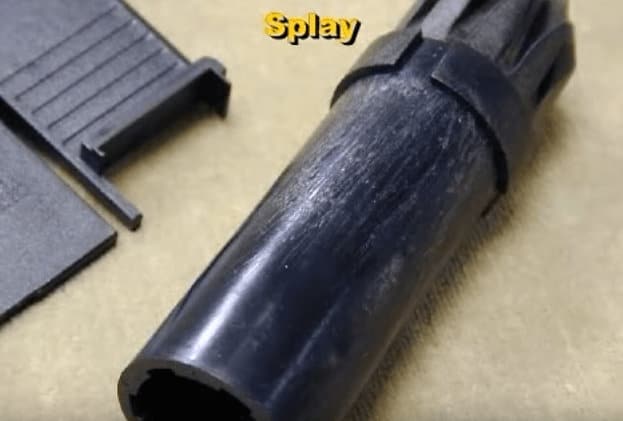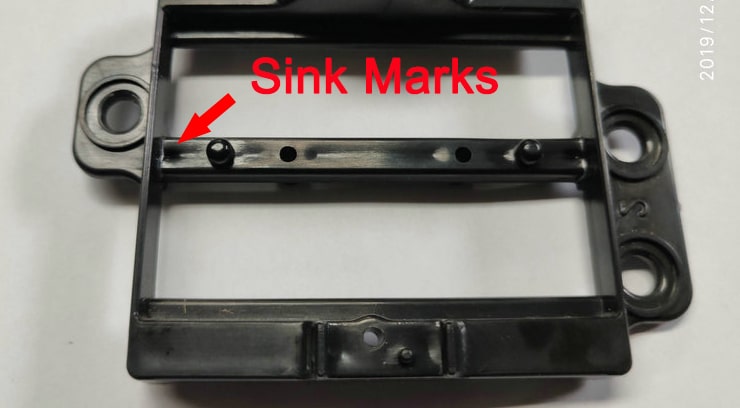PC/ABS Injection Molding
PC/ABS, mixture of Polycarbonate and acrylonitrile butadiene ,is a thermoplastic plastics made of polycarbonate and polyacrylonitrile (ABS), which combine the excellent characteristics of the two materials, the injection-ability of ABS and the mechanical properties, impact strength, temperature resistance, ultraviolet (UV) resistance of PC.

Silver streak is the most common problem of PC/ABS materials injection.
Silver streak is also called silver grain and silver splash, etc. It is a silvery white stripe phenomenon on the surface of products along the flow direction.
The source is mainly divided into three fields:

Solution:
First, check whether the plastic material is dry enough. After confirming , adjust the injection molding process to solve the silver streak problem. At the same time, the injection molding Silver streak is also related to mold venting.
Flow marks are produced during injection process. The main reason is that the materials have poor fluidity. Flow marks are different from silver streaks.
They are not caused by moisture or decomposition of materials, and their appearance is different.
Solution:
It can be avoided by raising the temperature of the material so as to improve the fluidity.
It can also appropriately raise the mold temperature to increase the fluidity of the material in the mold and reducing the injection speed.
Shrinkage is caused by insufficient filling of material in the mold cavity.
The dent of PC/ABS injection molded parts is caused by improper material temperature and poor product design. When the plastic material temperature is too low, not only shrinkage but also surface dent will occur. If the plastic material temperature and the mold temperature is too high, the melt will shrink excessively when cooling down, which will result in surface dent.

solution:
The mold temperature and the material temperature are appropriately increased to improve the material fluidity, prolong the injection pressure back time, increase the injection pressure, increase the injection speed to improve the mold filling , and also increase the gate size and hot runner to reduce even eliminate the shrinkage of the product.
Warping and deformation of injection molded parts is caused by unreasonable design of the parts, improper gate position and unreasonable injection molding processing .
they will result in internal stress, uneven shrinkage .
Too high or uneven mold temperature will lead to demoulding difficulty of the parts, or uneven cooling will also cause warping deformation.
Solution:
Injection molding setting: prolong the injection molding cycle, reduce the injection temperature, adjust the injection pressure and injection speed, reduce the ejection speed, increase the ejection area, and keep the ejection force balanced;
Product design: increase wall thickness, design more ribs and fillets.
It is usually due to "melt fracture" caused by melt expanding into the mold cavity during high-speed injection.
solution:
(1) injection molding : increase the plastic material temperature and the nozzle temperature, slow down the injection speed
(2) mold: raise mold temperature, increase gate size and modify gate shape.
The peeling of plastic products is related to the fracture of molecule caused by high shear stress. At low shear stress or rate, small disturbances are contained by melt. However, at high shear stress or velocity, the disturbance in the fluid is difficult to suppress and develops into unstable flow. When a max shear force is reached, the fluid will be cracked.
solution:
(1) plastic material: PC and ABS are partially compatible, so proper compatibilizer must be added in the modification process to improve the compatibility. The first step is to eliminate the peeling caused by mixing materials.
(2) Mold: The principle of mold design shall be of minimizing shearing. Generally, products with dense texture surfaces are more prone to peeling (caused by friction and shearing of melt in the cavity and the inner wall of the cavity during high-speed filling); At the same time, if the gate size is too small, excessive shearing will occur when the melt passes through the gate, which will lead to peeling product surface.
(3) Injection molding : the guideline is to avoid excessive shearing. When the product is difficult to fill, it can be improved by high speed and high pressure. Therefore, in the actual injection process, the flow resistance can be reduced by means of increasing the injection temperature/mold temperature and improving the material fluidity, thus avoiding excessive shearing caused by high speed and high pressure.

1. Silver Streak
Silver streak is the most common problem of PC/ABS materials injection.
Silver streak is also called silver grain and silver splash, etc. It is a silvery white stripe phenomenon on the surface of products along the flow direction.
The source is mainly divided into three fields:
- (1) Air: the air involved in the melting and injection phases;
- (2) moisture: moisture contained in the plastic material itself;
- (3) decomposition: gas generated by high-temperature hydrolysis/thermal material decomposition.

Solution:
First, check whether the plastic material is dry enough. After confirming , adjust the injection molding process to solve the silver streak problem. At the same time, the injection molding Silver streak is also related to mold venting.
2. Flow mark
Flow marks are produced during injection process. The main reason is that the materials have poor fluidity. Flow marks are different from silver streaks.
They are not caused by moisture or decomposition of materials, and their appearance is different.
Solution:
It can be avoided by raising the temperature of the material so as to improve the fluidity.
It can also appropriately raise the mold temperature to increase the fluidity of the material in the mold and reducing the injection speed.
3, shrinkage and dent
Shrinkage is caused by insufficient filling of material in the mold cavity.
The dent of PC/ABS injection molded parts is caused by improper material temperature and poor product design. When the plastic material temperature is too low, not only shrinkage but also surface dent will occur. If the plastic material temperature and the mold temperature is too high, the melt will shrink excessively when cooling down, which will result in surface dent.

solution:
The mold temperature and the material temperature are appropriately increased to improve the material fluidity, prolong the injection pressure back time, increase the injection pressure, increase the injection speed to improve the mold filling , and also increase the gate size and hot runner to reduce even eliminate the shrinkage of the product.
4, warping and deformation
Warping and deformation of injection molded parts is caused by unreasonable design of the parts, improper gate position and unreasonable injection molding processing .
they will result in internal stress, uneven shrinkage .
Too high or uneven mold temperature will lead to demoulding difficulty of the parts, or uneven cooling will also cause warping deformation.
Solution:
Injection molding setting: prolong the injection molding cycle, reduce the injection temperature, adjust the injection pressure and injection speed, reduce the ejection speed, increase the ejection area, and keep the ejection force balanced;
Product design: increase wall thickness, design more ribs and fillets.
5. Wavy surface
It is usually due to "melt fracture" caused by melt expanding into the mold cavity during high-speed injection.
solution:
(1) injection molding : increase the plastic material temperature and the nozzle temperature, slow down the injection speed
(2) mold: raise mold temperature, increase gate size and modify gate shape.
6, peeling
The peeling of plastic products is related to the fracture of molecule caused by high shear stress. At low shear stress or rate, small disturbances are contained by melt. However, at high shear stress or velocity, the disturbance in the fluid is difficult to suppress and develops into unstable flow. When a max shear force is reached, the fluid will be cracked.
solution:
(1) plastic material: PC and ABS are partially compatible, so proper compatibilizer must be added in the modification process to improve the compatibility. The first step is to eliminate the peeling caused by mixing materials.
(2) Mold: The principle of mold design shall be of minimizing shearing. Generally, products with dense texture surfaces are more prone to peeling (caused by friction and shearing of melt in the cavity and the inner wall of the cavity during high-speed filling); At the same time, if the gate size is too small, excessive shearing will occur when the melt passes through the gate, which will lead to peeling product surface.
(3) Injection molding : the guideline is to avoid excessive shearing. When the product is difficult to fill, it can be improved by high speed and high pressure. Therefore, in the actual injection process, the flow resistance can be reduced by means of increasing the injection temperature/mold temperature and improving the material fluidity, thus avoiding excessive shearing caused by high speed and high pressure.
[…] have rich experience in the production of extra wall thickness poly-carbonates and ABS/PC injection molding […]
ReplyDelete